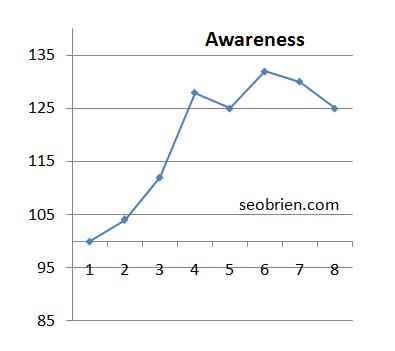The concept of using behavior, namely search behavior, to understand user intent and awareness is difficult to grasp. In an industry in which focus groups and panels are the norm, the most alien of insights is that of the searcher but, consider, the ability to track the behavior of an immense audience actively seeking, evaluating, and purchasing your product or service is an opportunity to great to ignore.
But how does one do that? How do I model different activities and assign those models to traditional indicators of success? We do so plotting the following general activities against an index and monitoring patterns that reveal changes in behavior.
The 5 marketing metrics of success
- Awareness – My customer must be aware of my brand, product, or service
- Interest – My intent is to create interest
- Consideration – I hope to influence consideration of my brand against others’
- Intent – This is where most marketers focus, I want to measure the influence I have on my customers intentions to: buy, sign up, contribute, pay me.
- Loyalty – Keep them for the long haul
Successful marketing demands positive influence of those 5 factors.
If I were to start a an ad campaign tomorrow, I would, at that point, create an index measuring various metrics and set the value of those metrics at 0 (or effectively so). One of those metrics might be searches for my brand name; quite simply, using the fact that a user is searching for your brand as an indication that the user is aware of my brand. Tomorrow, I track 1000 searches for my brand name, that becomes my bench mark, my guiding light, the number from which all activity matters. Why? My campaign had better make more customers aware of my brand and in turn, search for my brand. An increase in those searches indicates success. Over the coming 8 weeks of my campaign, searches for my brand increase creating a plot not unlike what you see here.
One of those metrics might be searches for my brand name; quite simply, using the fact that a user is searching for your brand as an indication that the user is aware of my brand. Tomorrow, I track 1000 searches for my brand name, that becomes my bench mark, my guiding light, the number from which all activity matters. Why? My campaign had better make more customers aware of my brand and in turn, search for my brand. An increase in those searches indicates success. Over the coming 8 weeks of my campaign, searches for my brand increase creating a plot not unlike what you see here.
As I’ve suggested in the past though, this science is not as simple as plotting one activity as a measure of success. My campaign does not simply create awareness for my brand as it also drives sales, newsletter registrations, consideration, and loyalty. How do I take all that into account?
Start by mapping out the activities you can track against the metrics of success:
-
- Awareness – Searches for your brand or products
- Interest – Click throughs on those searches, multiple searches
- Consideration – Click through on only products or services, aggregate visits to your product content
- Intent – Searches on “action” related terms: buy, compare, and order, as well as the % of users adding things to their cart
- Loyalty – Searches for accessories, parts, support, and customer service. Remember, this methodology is dependent on your constantly running a search program for anything someone might be searching so that you can track and model all interest and demand. The results deliver what I consider the most insightful dashboard of campaign performance.
 In the chart seen here we’re plotting multiple activities and tracking changes in behavior relative to the 5 core marketing metrics. Over the 8 weeks of the campaign, noted interest in my product peaked, with awareness of my brand, as I measured an apex in click throughs on searches for my brand and products as well as the greatest frequency of multiple searches (brand -> product -> store name -> brand). Initially, consideration for my product fell as customers were perhaps confused by the new ad and needed time to absorb the message. And intent plummets most rapidly as my campaign ends suggesting the ads’ tremendous influence on customer’s purchasing product; after the ads disappear, so do purchases.
In the chart seen here we’re plotting multiple activities and tracking changes in behavior relative to the 5 core marketing metrics. Over the 8 weeks of the campaign, noted interest in my product peaked, with awareness of my brand, as I measured an apex in click throughs on searches for my brand and products as well as the greatest frequency of multiple searches (brand -> product -> store name -> brand). Initially, consideration for my product fell as customers were perhaps confused by the new ad and needed time to absorb the message. And intent plummets most rapidly as my campaign ends suggesting the ads’ tremendous influence on customer’s purchasing product; after the ads disappear, so do purchases.

[…] read more | digg story […]
Wow, thanks for a great post. We constantly struggle to convince clients that it is crucial to keep a basic branding campaign running even between special promotions, etc. to keep awareness of the brand high.
[…] Modeling Search and User Behavior to Measure Campaign Performance […]
[…] and comScore highlighting the power of search behavior as a window into your customer, a topic we discussed here just a month ago. WebGuild’s approach to search marketing is a fresh blend of entry and […]
[…] POSTS Conversion Rate from Paid & Natural Search is equal!?!?Modeling Search and User Behavior to Measure Campaign PerformanceViral Marketing Case Study?Close the Loop Yahoo!Google’s Top 100 Validates Search as a Gold […]